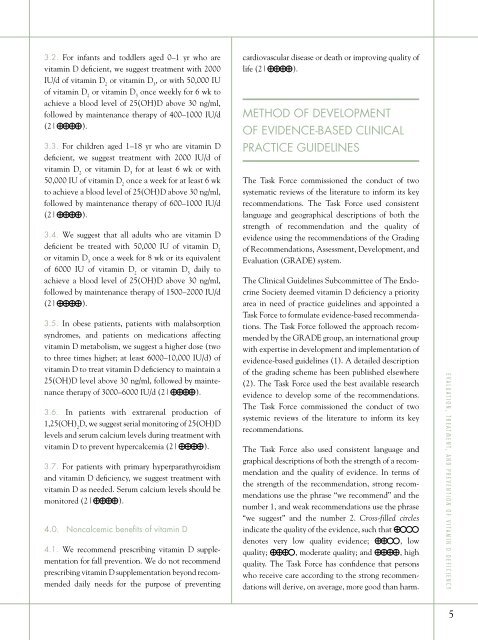FINAL-Standalone-Vitamin-D-Guideline
FINAL-Standalone-Vitamin-D-Guideline
FINAL-Standalone-Vitamin-D-Guideline
- No tags were found...
Create successful ePaper yourself
Turn your PDF publications into a flip-book with our unique Google optimized e-Paper software.
3.2. For infants and toddlers aged 0–1 yr who arevitamin D deficient, we suggest treatment with 2000IU/d of vitamin D 2or vitamin D 3, or with 50,000 IUof vitamin D 2or vitamin D 3once weekly for 6 wk toachieve a blood level of 25(OH)D above 30 ng/ml,followed by maintenance therapy of 400–1000 IU/d(2| ).3.3. For children aged 1–18 yr who are vitamin Ddeficient, we suggest treatment with 2000 IU/d ofvitamin D 2or vitamin D 3for at least 6 wk or with50,000 IU of vitamin D 2once a week for at least 6 wkto achieve a blood level of 25(OH)D above 30 ng/ml,followed by maintenance therapy of 600–1000 IU/d(2| ).3.4. We suggest that all adults who are vitamin Ddeficient be treated with 50,000 IU of vitamin D 2or vitamin D 3once a week for 8 wk or its equivalentof 6000 IU of vitamin D 2or vitamin D 3daily toachieve a blood level of 25(OH)D above 30 ng/ml,followed by maintenance therapy of 1500–2000 IU/d(2| ).3.5. In obese patients, patients with malabsorptionsyndromes, and patients on medications affectingvitamin D metabolism, we suggest a higher dose (twoto three times higher; at least 6000–10,000 IU/d) ofvitamin D to treat vitamin D deficiency to maintain a25(OH)D level above 30 ng/ml, followed by maintenancetherapy of 3000–6000 IU/d (2| ).3.6. In patients with extrarenal production of1,25(OH) 2D, we suggest serial monitoring of 25(OH)Dlevels and serum calcium levels during treatment withvitamin D to prevent hypercalcemia (2| ).3.7. For patients with primary hyperparathyroidismand vitamin D deficiency, we suggest treatment withvitamin D as needed. Serum calcium levels should bemonitored (2| ).4.0. Noncalcemic benefits of vitamin D4.1. We recommend prescribing vitamin D supplementationfor fall prevention. We do not recommendprescribing vitamin D supplementation beyond recommendeddaily needs for the purpose of preventingcardiovascular disease or death or improving quality oflife (2| ).Method of Developmentof Evidence-Based ClinicalPractice <strong>Guideline</strong>sThe Task Force commissioned the conduct of twosystematic reviews of the literature to inform its keyrecommendations. The Task Force used consistentlanguage and geographical descriptions of both thestrength of recommendation and the quality ofevidence using the recommendations of the Gradingof Recommendations, Assessment, Development, andEvaluation (GRADE) system.The Clinical <strong>Guideline</strong>s Subcommittee of The EndocrineSociety deemed vitamin D deficiency a priorityarea in need of practice guidelines and appointed aTask Force to formulate evidence-based recommendations.The Task Force followed the approach recommendedby the GRADE group, an international groupwith expertise in development and implementation ofevidence-based guidelines (1). A detailed descriptionof the grading scheme has been published elsewhere(2). The Task Force used the best available researchevidence to develop some of the recommendations.The Task Force commissioned the conduct of twosystemic reviews of the literature to inform its keyrecommendations.The Task Force also used consistent language andgraphical descriptions of both the strength of a recommendationand the quality of evidence. In terms ofthe strength of the recommendation, strong recommendationsuse the phrase “we recommend” and thenumber 1, and weak recommendations use the phrase“we suggest” and the number 2. Cross-filled circlesindicate the quality of the evidence, such thatdenotes very low quality evidence; , lowquality; , moderate quality; and , highquality. The Task Force has confidence that personswho receive care according to the strong recommendationswill derive, on average, more good than harm.E v a l u a t i o n , T r e a t m e n t , a n d P r e v e n t i o n o f V i t a m i n D D e f i c i e n c y5


